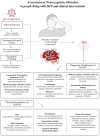The Role of Nutrition in HIV-Associated Neurocognitive Disorders: Mechanisms, Risks, and Interventions
- PMID: 40566634
- PMCID: PMC12194385
- DOI: 10.3390/life15060982
The Role of Nutrition in HIV-Associated Neurocognitive Disorders: Mechanisms, Risks, and Interventions
Abstract
HIV-associated neurocognitive disorders (HANDs) refer to a range of cognitive deficits that afflict people living with the Human Immunodeficiency Virus (HIV). The fundamental processes of HAND include persistent inflammation, immunological activation, and direct viral impact on the central nervous system. Emerging research shows that nutritional status, especially food consumption and body weight, is critical in determining the course and severity of HAND. Malnutrition exacerbates neurocognitive impairment by increasing inflammation and oxidative stress, while obesity may contribute to HAND through the promotion of metabolic disruption, gut microbiota alterations, and systemic inflammation. Additionally, the introduction of antiretroviral treatment (ART) has substantially enhanced the prognosis of people living with HIV by lowering viral load and improving immune function. However, depending on the regimen, ART can cause changes in body weight, which may influence the progression of HAND. This emphasizes the intricate interplay between HIV, nutrition, body weight, and neurocognitive health. As a result, various dietary approaches are currently being investigated to improve the quality of life of individuals with HIV and possibly help prevent neurocognitive decline in this population. This review aims to elucidate the relationship between nutrition and neurocognitive function in individuals living with HIV, shedding light on aspects of HANDs related to diet, body weight fluctuations, and metabolic syndrome. It explores the shift from current pharmacological treatments to innovative non-pharmacological interventions, including specific dietary strategies, to support overall health and cognitive well being in HIV-positive people.
Keywords: HIV-associated neurocognitive disorders (HANDs); acquired immunodeficiency syndrome (AIDS); anti-retroviral therapy (ART); body weight; food; human immunodeficiency virus (HIV); inflammation.
Conflict of interest statement
The authors declare no conflict of interest.
Figures



Similar articles
-
Progressive resistive exercise interventions for adults living with HIV/AIDS.Cochrane Database Syst Rev. 2004 Oct 18;(4):CD004248. doi: 10.1002/14651858.CD004248.pub2. Cochrane Database Syst Rev. 2004. PMID: 15495092
-
Systemic pharmacological treatments for chronic plaque psoriasis: a network meta-analysis.Cochrane Database Syst Rev. 2021 Apr 19;4(4):CD011535. doi: 10.1002/14651858.CD011535.pub4. Cochrane Database Syst Rev. 2021. Update in: Cochrane Database Syst Rev. 2022 May 23;5:CD011535. doi: 10.1002/14651858.CD011535.pub5. PMID: 33871055 Free PMC article. Updated.
-
WITHDRAWN: Interventions for fatigue and weight loss in adults with advanced progressive illness.Cochrane Database Syst Rev. 2017 Apr 7;4(4):CD008427. doi: 10.1002/14651858.CD008427.pub3. Cochrane Database Syst Rev. 2017. PMID: 28387447 Free PMC article.
-
Interventions for fatigue and weight loss in adults with advanced progressive illness.Cochrane Database Syst Rev. 2012 Jan 18;1:CD008427. doi: 10.1002/14651858.CD008427.pub2. Cochrane Database Syst Rev. 2012. Update in: Cochrane Database Syst Rev. 2017 Apr 07;4:CD008427. doi: 10.1002/14651858.CD008427.pub3. PMID: 22258985 Updated.
-
Structured treatment interruptions (STI) in chronic unsuppressed HIV infection in adults.Cochrane Database Syst Rev. 2006 Jul 19;2006(3):CD006148. doi: 10.1002/14651858.CD006148. Cochrane Database Syst Rev. 2006. PMID: 16856117 Free PMC article.
References
-
- Gottlieb M.S., Schroff R., Schanker H.M., Weisman J.D., Fan P.T., Wolf R.A., Saxon A. Pneumocystis carinii pneumonia and mucosal candidiasis in previously healthy homosexual men: Evidence of a new acquired cellular immunodeficiency. N. Engl. J. Med. 1981;305:1425–1431. doi: 10.1056/NEJM198112103052401. - DOI - PubMed
-
- Masur H., Michelis M.A., Greene J.B., Onorato I., Stouwe R.A., Holzman R.S., Brettman L., Lange M., Murray H.W., Cunningham-Rundles S. An outbreak of community-acquired Pneumocystis carinii pneumonia: Initial manifestation of cellular immune dysfunction. N. Eng. J. Med. 1981;305:1431–1438. doi: 10.1056/NEJM198112103052402. - DOI - PubMed
-
- Centers for Disease Control and Prevention (CDC) Pneumocystis pneumonia—Los Angeles. MMWR Morb. Mortal. Wkly. Rep. 1981;30:250–252. - PubMed
-
- National Institute of Health (Reviewed 2025 March 31) The Stages of HIV Infection. [(accessed on 18 June 2025)]; Available online: https://hivinfo.nih.gov/understanding-hiv/fact-sheets/stages-hiv-infection.
Publication types
Grants and funding
LinkOut - more resources
Full Text Sources
Research Materials

